2009/12/26
High Resolution Lunar Mosaic
2009/12/19
My Dark Age
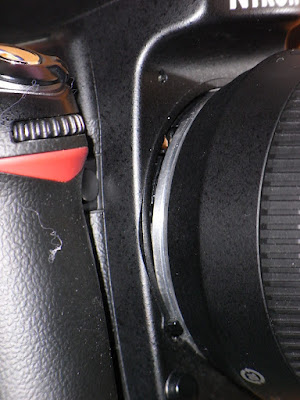 My D80 was seriously damaged! See the gap between the lens and the body. This part is supposed to be very tough! But cracked now!!!
My D80 was seriously damaged! See the gap between the lens and the body. This part is supposed to be very tough! But cracked now!!!2009/11/30
Reprocess the 28-11-2009 Lunar Mosaic
2009/11/28
Lunar Mosaic
2009/11/25
The Lunar X
This was the first time I seriously use the new eyepieces, Baader Planetarium 8-24mm zoom, Tele Vue Nagler 3-6mm zoom and Tele Vue 2-4mm zoom. However, the instrument is nothing more important than the observation. I started the observation at about 6:00pm. The moon & Jupiter were hanging in the sky. When I pointed the M8 ACF to the moon, I quickly recognized the Lunar X. This is the first time I saw it and I remember that it can be seen in certain moon phase. However, I must good home because my two little daughters were waiting for me. So I packed all the telescopes and went home. I thought I can take the Lunar X after dinner.
After the diner and father’s evening duties, I started to image the moon at about 10:00pm. Oh Gosh! The Lunar X was not as obvious as that at 6:00pm (Moon age 7.615). It was stand out at 6:00pm, but now it was pale. I did everything in rush. Finally I made it! After that I search the Lunar X information in the Internet. The Lunar X can only be seen in 4 hours just before the quarter!
http://www.astropix.com/HTML/SHOW_DIG/097.HTM
Lucky me! I made it! My next challenges are high resolution lunar mosaic and high power magnification lunar features.
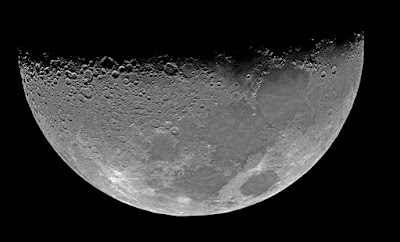
Moon age 7.781, Equinox 80ED, DMK 41, Porta mount, 482 out of 500 frames stacked, Registax 5, PS CS4

2009/11/20
Equinox 66 Vs Tak FS60C
I went to David’s school at about 5:00pm yesterday. We setup all the scopes quickly. David’s students were good helpers and little judges. I guess they are trained to be experienced telescope users. The main disc was Equinox 66ED Vs Tak FS60C. However, there was another super star TMB 80/480. The main concern was the chromatic aberration. We selected some white light sources from distant buildings. In addition, we luckily found some really small bright spots which can be treated as point source. So we did “star test” as well. However, one should be reminded that these artificial objects were much brighter than Sirius and even Venus. Using these artificial sources was extremely harsh to telescopes.
At the first sign, both scopes are strongly built. I like both focusers, although Tak FS60C got no dual speed, it is firm and solid. While the Equinox’s dual speed focuser makes focusing easier. We used the Nagler 2-4mm zoom and Nagler 3-6mm zoom. Ordinary diagonals used were used. For comparison purpose we set the magnifications of Equinox and Tak to 400/3 = 133X and 360/3 = 120X respectively. Despite low contrast, both scopes didn’t breakdown even at 2mm eyepiece focal length. The trends of CA of both scopes were similar. There were some violet in front of the focus and some green behind the focus. However the degree of CA was different. The CA of Tak FS60C was very small. The CA of Equinox was small. Both scopes gave good “star test” results. All the diffraction rings were symmetrical. However the pattern in front of the focus and behind the focus in the case of Tak FS60C was a bit better. We repeated all the comparisons by swapping the Nagler 2-4mm zoom and Nagler 3-6mm zoom, the results were the same, which means the differences were not from the eyepieces, but the scopes. Anyway, the difference in CA was not big in fact. So what really make the difference in this comparison? Resolution!!! David and I found that the resolution tells the difference. Tak FS60C gave shaper images.
About the CA of Equinox 120ED, it was reported in Cloudy Nights that if one stops down an Equinox 120ED to 110mm, it was virtually color free. So I tested this idea in Equinox 66ED. Since I could not find a compass this morning, I used a cap to draw a circle. The diameter of the stopper was then 58.5mm. There was still CA exists and showed a bit improvement in violet. I couldn’t see improvement in green.
Well, the final verdict cannot be made. The reason is that in real sky observations, stars are much dimmer that artificial lights. The observed CA in very bright artificial lights may not be detectable by human eyes in the case of real stars, so further test is needed.
2009/11/10
DIY Bi-scope Platform
 Parts: Aluminum plate, Vixen Porta mount, Vixen dovetail saddle, Sky-watcher dovetail
Parts: Aluminum plate, Vixen Porta mount, Vixen dovetail saddle, Sky-watcher dovetail
Weight of Bi-scope Platform
A Quick Observation
2009/10/27
Lunar Image Taken with Equinox 66ED
2009/10/26
Equipment Testing: Equinox 66ED
Goodbye Orion Meteoroid Shower
In Search of Good Observation Sites
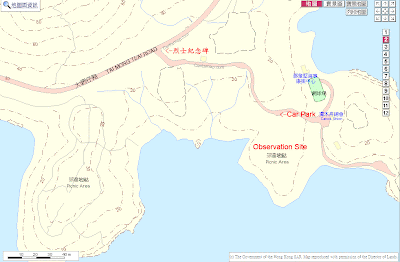

2009/10/19
Equipment Testing: Meade 8 ACF, APM/TMB 80/600 & Equinox 66ED
The long waited Meade 8” SCT AFC was finally settled! The order has been delayed for many times and I’ve disappointingly waited for half years. Finally I got an offer from a local stargazer who bought this telescope in a special offer given by the local dealer half years ago. The reason that he sold this M8 was that he got another extremely cheap LX200 offer. The M8 ACF he sold to me was very new. It has been used in field, Pak Tam Chung, for once only. I was lucky enough to get it because another stargazer told me about this and I responded fast enough to it, or the chance would go! It is very hard to get a used M8 ACF in Hong Kong. Although he sold me at the same price he paid half years ago, it was still a good price and it healed my pain at once! Last night, the sky condition was so so. The transparency was ok, but the seeing was bad. With clouds running around, I could hardly catch a few moments to look at Jupiter. Nothing could be concluded, but the M8 worked. The maximum magnification I tried was 2000/9 = 222X.
Another encounter was the trial of the APM/TMB 80/600 APO. I went to the Sky-watcher dealer and replaced the long tripod with a short tripod for the EQ3Pro. Sky-watcher is certainly a homely-made like manufacturer. Their product specifications change from time to time and even their dealer doesn’t know it! Their product specifications can be modified according to requests! This is odd, but flexible right! I am an efficient guy. I know the dealer got a used APM/TBM 80/600. It would be nice if I can have a look at it before it was sold to somebody else. I deliberately arranged the tripod replacement and the glance of the APM/TBM APO in one go. Ha Ha! In fact the main course was the APO… Well, it was daytime, I did the terrestrial observations only. The first eyepiece I tried on the APM/TMB 80/600 was 25mm Aspheric Orthoscopic. When you look through the eyepiece, the feeling was WOW! The image was so sharp and the contrast was so high. The image was sharp to the edge of the field. This telescope was the best I’ve ever seen for terrestrial observation! I cannot imagine what will happen if I use the APM/TBM 203 to do terrestrial observations! The color tone was warm. The Aspheric Orthoscopic gave good eye relief and the field was reasonably wide. The viewing was so pleasing and comfortable. When I put the 16mm TBM Super Monocentric, which is supposed to be a top planetary eyepiece, the off-axis image was a bit blur. However, the image around the principal axis was extremely sharp and of very high contrast. The color of the Mono was not as warm as Orthoscopic. I didn’t have the chance to compare these two eyepieces on viewing stars side by side that day. I couldn’t comment which one was better for stargazing. It would be nice to do it later. Finally I tried the 13mm Ethos. There is no need to mention about its field of view. The viewing was very comfortable. The image was sharp and the contrast was high. I couldn’t tell the difference in sharpness between Aspheric Orthoscopic and Ethos. Both are very good eyepieces, which need longer observation and being tested to differentiate. Again I was in a rush to go! So try again next time.
I borrowed the Equinox 66ED from the dealer for a short period of time. I tried it in daytime recently. A first look at this little scope, it inherited the beauty build of Equinox series. I have tried Equinox 80ED and 120ED, now the 66ED. The only Equinox I didn’t try is the 100ED. Well, the optic of this scope was good. I used Skywatcher eyepieces and Tele Vue 2.5X and 5X Powermates in the entire testing. For daytime terrestrial observation, if the magnification was below or equal to 400/5 = 80, the color, sharpness and contrast are very good. It doesn’t mean it will breakdown when the magnification goes beyond 80, but will not be too promising to use it for birding or other terrestrial observations as the contrast and the brightness are low. I tried to boost the magnification to 400/8*2.5 = 125X and 400/15*5 = 133X respectively. I was able to see the price tag of a fruit store. I guess the characters’ size was about 5cm and the store was about 1.5km apart. A quick estimated resolution to achieve such an observation is 5X10^-2/1.5X10^3 = 3.3X10^-5. The Rayleigh resolution, theoretical maximum, is 1.2X550X10^-9/66X10^-3 = 1.0X10^-5. It is not bad right! However, if it is used for stargazing, the magnification can be boosted further since the background is much darker. It all depends on what celestial objects you are going to watch. For the 200X, I tried in different settings, 400/2 = 200X and 400/5X2.5 = 200X. The 400/2 = 200X gave a slightly better performance in terms of sharpness and contrast. At such magnification, the contrast was very low. However, the image didn’t breakdown completely. One could still see some details. The corresponding magnification per inch is above 70X. It is a good figure already. I owned a small achromatic refractor, Meade ETX 80. Its optical performance cannot be compared with Equinox 66ED in terms of chromatic aberration and resolution. To be fair, the price of ETX70 was just a few hundred. Although optically it is a loser, it is a best buy.
2009/09/26
Top equipment, but hazy sky!
At a first glance, the tube material was robust lightweight polymer. Both 100mm/F800mm and 130mm/F1200mm can be mounted on EQ3Pro. I forgot to carry both APOs and got a feeling of how heavy they were, but they should not belong to heavy class. Everything was strongly and nicely built. The base and the bracket of the finder scope were quite unique. I would not say it is stylish, but the design concept was neither Japanese nor Chinese, but German. The Feather Touch focuser was solid. Well back to the main dish, optical performance. Both APOs delivered high contrast images. I tried another 12” Newtonian last night. The Newtonian deliver brighter images, but it contrast was far below than that of APOs at similar magnifications. We boosted the magnifications to 288X and ~500X for 100mm/F800mm and 130mm/F1200mm respectively. These mean we pushed the limit to 72X/inch (288X) and 96X/inch (500X) respectively. The 100mm/F800mm was able to handle 72X/inch. Although the Jupiter image was breakdown under 96X/inch for the 130mm/F1200mm, one could still see some color fringes of Jupiter. That was not a flat images disc of Jupiter.
Last night there were two points I especially want to mention, the chromatic aberration and the resolution of the surfaces the Jupiter’s satellites. When I used the APOs to observe the Jupiter, the north pole of the Jupiter was a bit bluish. The dealer said it was due to atmospheric chromatic aberration, not the chromatic aberration of the APO. Here comes the question! Is the dealer telling the truth? To me, this is a physics question. If the optics got no or low astigmatism, the chromatic aberration should be cylindrical symmetric. There should be false color around the star, not just appearance in certain direction. My conclusion is that the bluish color at the north pole of Jupiter was caused by atmospheric aberration. One can do some experiments to verify this. Use the same telescope to observe the same object and see if the position of the aberration changes with time. About the resolution of the surface of the Jupiter’s satellites, moon surface, we saw all four satellites, IO, Europa, Callisto and Ganymede. The dealer and I were not sure about the moon surfaces were revealed or they were just Airy discs. As the magnitude of those satellites were small, probably larger than 5. When I observed the satellites by the 100mm/F800mm APO, it seemed that I saw the 1st order diffraction ring, but I was not sure. But it was possible that it was Airy disc. When we used the 130mm/F1200mm APO, the image of the satellite improved a bit. The hazy sky kept on discourages us whole night. It seemed that the 130mm/F1200mm APO gave a more solid image. However, it was illusion or fact. We need to wait for the sky. But it is highly possible that these two APOs will be delivered to new owners. So what can I do! Ha! Ha! Use theory to justify it! As these two APOs were claimed to be diffraction limited, we can do some calculations and see if it is possible to see the moon surface.
The visual angles in arc second of the satellites are:
IO 1.2”
Europa 1”
Callisto 1.6”
Ganymede 1.7”
By using the Rayleigh Criteria, we can calculate the theoretical limit of the resolution of the telescope.
R = 1.2 L/D where R is the resolution, L is the wavelength and D is the diameter.
The resolution calculated is in radian, we can convert it back to degree easily. In order to get a feeling of how good is the optics, I assume the average wavelength of visible light to be 550nm. After some simple calculations, for diffraction limited optics, the resolution of different diameter in arc second is given below:
100mm 1.36”
130mm 1.05”
203mm 0.67”
It means that 100mm APO is not able to resolve the Jupiter’s moon surface. The image was just an Airy disc. The 130mm APO can barely resolve the Jupiter’s moon surface. The 203mm APO can resolve Jupiter’s moon surface. This is a simple discussion, meaning that if the optics is diffraction limited, it is possible to resolve it. On the other hands, the practical optic is not possible to go beyond the theoretical limit.
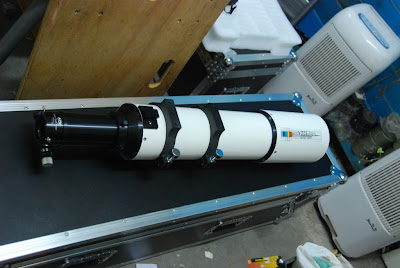
APM 100mm/F800mm
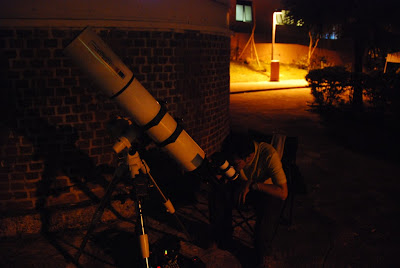
APM 130mm/F1200mm
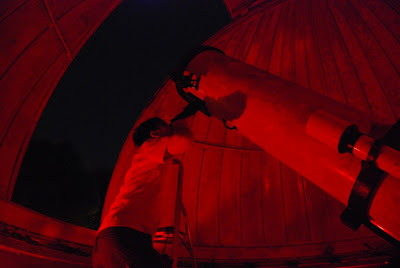
Newtonian 305mm/F8.5
2009/09/23
Equinox 120ED and DBK21
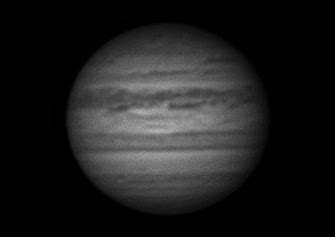
Jupiter, Equinox 120ED, TV 5X, DBK 21
2009/09/05
The Delighting Jupiter and Moon 賞心「月木」
Last night was the first stargazing activity this academic year. I made an elegant Chinese name for this activity, 賞心「月木」Delighting Jupiter and Moon. I used the Stellarium to find out the appropriate time to hold this activity. It was because my school was surrounded by a public housing estate and a hill. The field of view from the school roof is very narrow. Without careful planning, the observation would definitely be doomed! Originally I planned during the observation time, the Jupiter and the moon would appear between the gap of two buildings, finally I changed the observation site from the school’s roof to a nearby roundabout. I guessed students would be happier with an unobstructed view.
After a short introduction about the Jupiter and the Moon, we went to a nearby roundabout. The transportation was easy as we had about 20 students. However, the setting was quite exhausting! The temperature was high and I needed to setup three telescopes. Finally I gave up and ended up with two refractors. You know I need to control and discipline about 20 students in the street and at the same time I needed to setup the equipment, it was really something! A few of my students were good. They asked if they could help. But I did not have enough time to train them about the setting. I dare not to let them do it! I don’t want to risk the expensive equipment. Well! I will train them afterward. Anyway, I finished the setting in wet! When I finished setting up the first telescope, Equinox 80ED, everyone was amazed by the Moon. This was the first time they saw maria and craters. The second wave came after the setting up of second refractor. The target was Jupiter. Everyone was shocked by the Jupiter and its 4 moons, Io, Europe, Ganymede and Callisto! This was the first time in their life that they had such a close contact with Jupiter! I was the prime master of climax! I deliberately increased the magnifications gradually. Every time when I boosted up the magnification, changed to a shorter focal length eyepiece, everyone was so amazed and excited! The only defect of the activity was that students needed to wait for a long time! The queue was quite long! When it was about 9:30pm, a few students reported me that there were a few drops of rain! I was scared and packed all the telescopes at once. When we backed school, there was no rain at all! What a false alarm! Some students were not very happy because they didn’t have a chance to look at the Jupiter! I promised them to organize anther activity shortly and they will have the first priority to join!
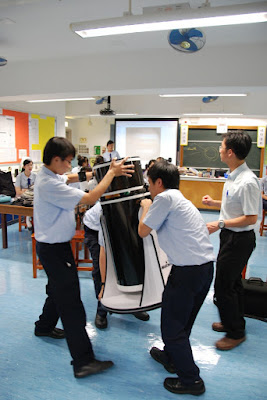
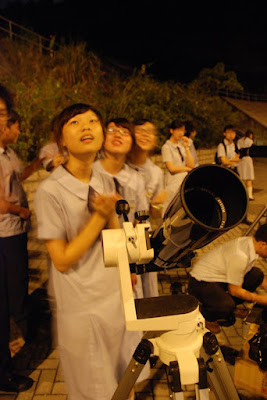


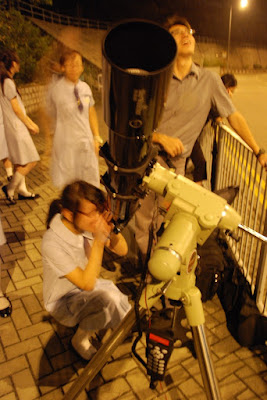
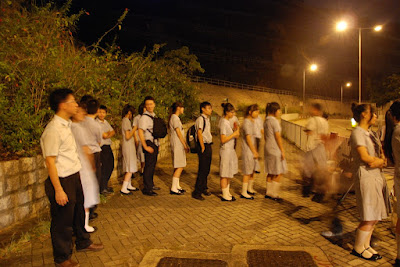
After dismissing the students, I stated in the school and did some more observations with another Physics teacher in the school. We used the Sky-Watcher 12” Dobsonian and Equinox 120ED. Due to the light pollution, we only observed the Moon and Jupiter. Both seeing and transparency were modest. The magnification was about 200-300X. We were not able to explore the limit of these two telescopes. However, the primarily visual ability was good. A further test is needed.
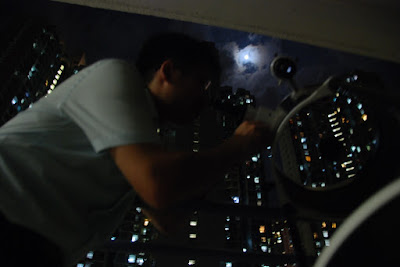
2009/08/15
Laser Hazard
1. Make sure no people in the direction of fire.
2. Shorten the fire time when you fire the laser.
3. Don’t wear shiny watches or decorations on your hands when you operate lasers.
4. Don’t look at the area around the laser pointer, even it is not directed at you.
5. Stand sideway to the one who is operating the laser.
Equipment Review

Tele Vue 2.5X and 5X Powermates

Unbranded 127mm F750m Refractor
2009/08/02
Sidewalk Astronomy and Telescopes Watching
After I walked around for a while in Tin Shui Wai, I decided to go to have my own star gazing. I rang my friend Lewis and our destination was Lung Ha Wan. We arrived at Lung Ha Wan at about 10:30pm. But the favorable location was occupied by some midnight divers! Gee! We wanted to try a new location, but it was just being occupied by others! Anyway, Lewis and I looked around and see if it was a good location for star gazing. But sky was very hazy and we could only see the Vega, the Jupiter and the moon. As there were no favorable car parks, we decided to go to good old Pak Tam Chung.
When we arrived Pak Tam Chung, there were no star gazers! I was fooled by those posts in the forum. Maybe everyone went to Tin Shui Wai. Well! We two lonely twins stated to setup our scopes and practice. The sky condition became very bad. When we arrived we could see the blurred moon, the fading Vega, the dim Polaris and Perhaps the bright Jupiter. I tried to setup the HEQ5Pro as quickly as possible. At the point I wanted to do the polar alignment, the Polaris was gone! So I used the compass to solve it. Unexpectedly the alignment done was quite good. The tracking of Jupiter was good. We shot the Jupiter with different imaging device, D90, 450D, SPC900NC and LPI. Both D90 and 450D have life-view which was very useful in focusing. But all the photos taken by D90 were unsatisfactory! We don’t know clearly why D90 failed. Maybe it was because of the flip mirror of D90 in the life-view mode flips before the release of the shutter, while 450D not. The small vibrations of flipping the mirror caused the burred images. As a Nikon user, I need to figure it out! This needs another investigation. My second task was to align the NexStar 4SE mount. It just couldn’t track the sun probably during the recent solar eclipse. I believe that ex-owner didn’t get it alignment in 2-star alignment or 3-star alignment once. According to the manual, one needs to get NexStar alignment once with at least 2-star alignment once before it works properly. However the noxious clouds covered the sky. You know! Finally I gave up and went to have dessert in Sai Kung. Today I tried to process my photos. I still don’t know how to use Registax. The photos shown were just click-click-click product.
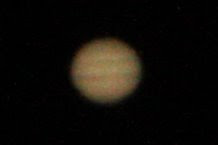 Jupiter: C5, TV 2.5X, ISO 1600, 1/25, 450D
Jupiter: C5, TV 2.5X, ISO 1600, 1/25, 450D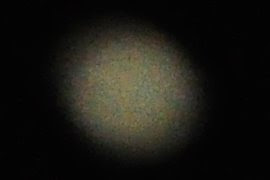 Jupiter: C5, TV 2.5X, ISO 1600, 1/25, D90
Jupiter: C5, TV 2.5X, ISO 1600, 1/25, D90 Jupiter: C5, SPC900NC, 1200 frames, Registax
Jupiter: C5, SPC900NC, 1200 frames, Registax 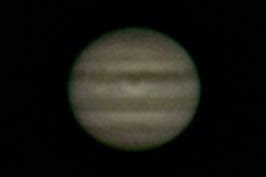























.jpg)
.jpg)

.jpg)
.jpg)
